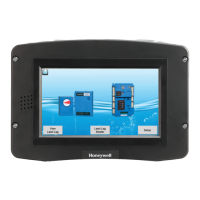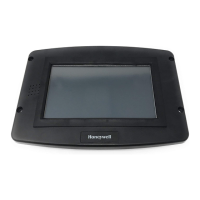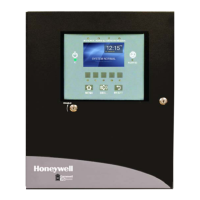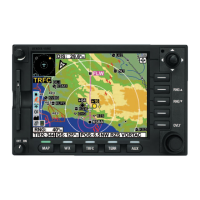Cut along dotted line.
NCD Operating Instructions
Section 1 Operating Information
Normal Standby Operation.
1. System Normal indicated on the Header Bar.
2. Green P
OWER LED lit steadily.
3. No Red F
IRE ALARM indication.
4. No Blue CO A
LARM indication.
5. No Yellow S
UPERVISORY, TROUBLE, DISABLE, OTHER or SIGNALS
S
ILENCED indications.
Alarm Condition.
1. Red FIRE ALARM, Blue CO ALARM, and/or Yellow OTHER indication(s) on
the touch screen display.
2. Alarm signaling devices activated.
3. Alarm information is visible on the touch screen display
Pre-Alarm Condition.
Alarm Reset. After locating and correcting the alarm condition, reset the
control panel by tapping the R
ESET touch point.
Trouble Condition. Activation of trouble signal under normal operation
indicates a condition that requires immediate attention. Contact your local
service representative. Silence the audible signal by tapping the A
CK touch
point. The trouble indication will remain on the NCD till the trouble is cleared.
Section 2 NCD Touch Point Functions
ACK (ACKNOWLEDGE). This silences the piezo sounder, steadies the
flashing event on the header bars, and changes each condition to
Acknowledged. If more than one event exists, it advances the display to the
next item and displays it until A
CKNOWLEDGE is tapped again. Only one tap is
necessary for non-fire, trouble, or supervisory signals. Fire alarms require one
tap for each activation.
SILENCE. The SILENCE touch point turns off all silenceable circuits and
illuminates the S
IGNALS SILENCED indicator on the Alert Bar. A subsequent
alarm will then resound the system.
RESET. Resets the NCD in standalone applications. Resets the associated
panel when enabled in network applications.
LAMP TEST. A Lamp Test can be performed via the Test/Diagnostics option
on the NCD. Press the Menu option and select Test/Diagnostics. Tap the
LAMP TEST touch point to turn on all pixels on the screen, sound the piezo,
and illuminate the Power and Off Normal Event LEDs for four (4) seconds.
Section 3 Event Indicators
Fire Alarm. Red indication that flashes on the Alert Bar when one or more
alarms occur. Illuminates steadily after alarms are acknowledged, and turns off
when R
ESET is pressed after the alarm(s) clear.
CO Alarm. Blue indication that flashes on the Alert Bar for a CO alarm.
Illuminates steadily after alarms are acknowledged, and turns off when R
ESET
is pressed after the alarm(s) clear.
Supervisory. Yellow Indication that flashes on the Alert Bar when a
Supervisory or Tamper condition occurs, such as a sprinkler valve tamper
condition. The indication illuminates steady after conditions are
acknowledged, and turns off when the conditions are cleared. A Tamper
indication will latch until R
ESET is pushed. RESET is required for any latched
event.
Security. A blue indication flashes on the Alert Bar when a security
activation occurs. Illuminates steadily after acknowledge is pressed, and turns
off when the security activation is cleared. R
ESET is required for any latched
event.
Trouble. Yellow indication that flashes on the Alert Bar when one or more
troubles occur. Illuminates steadily when A
CKNOWLEDGE is pressed, and turns
off when all trouble conditions are cleared.
Disable. Yellow indication that flashes on the Alert Bar when one or more
points are disabled. The display will indicate which points have been disabled.
Turns off when points are re-enabled.
Other Event. Yellow indication that flashes on the Alert Bar when a
Critical Process or Hazard /Weather Alert occurs . When a CO Pre-alarm
occurs, indication flashes blue, and a Pre-alarm indication will flash red.
Illuminates steady when Acknowledge is pressed, and turns off when the
condition is cleared.
Signals Silenced. Yellow indication that illuminates after SIGNALS
S
ILENCED has been pressed. Turns off when RESET is pressed.
Section 4 LED Indicators
Power. Green LED which illuminates when primary power is applied to the
NCD.
Off Normal. Yellow LED which illuminates when any off normal event is
present on the NCD.
Section 5 NCD Audible Sounder
Alarm. A continuous sounding tone.
Trouble, Disable, Pre-alarm. One beep per second.
CO-Alarm. Four beeps per second.
Supervisory. Four beeps per second.
Security. Eight beeps per second.
Other Event. Four beeps per second.
Section 6 Periodic Testing and Maintenance
To ensure proper and reliable operation, system inspection and testing should
be scheduled monthly, or as required by NFPA 72 or local fire codes. A
qualified Service Representative should perform testing.
Before Testing: Notify fire department if alarm condition is transmitted.
Notify facility personnel of the test so alarm sounding devices are ignored
during the test period. Physically disconnect all releasing devices.
After Testing: Notify all fire, and/or building personnel
when testing is complete. Re-connect releasing devices.
Section 7 Local Service Representative:
NAME: ________________________________________________
ADDRESS: _____________________________________________
TELEPHONE NUMBER: _________________________________
This sheet must be framed and mounted adjacent to the control panel.
Document LS10216-151-NF-E Rev B ECN 18-0487 01/16/2019

